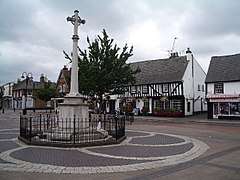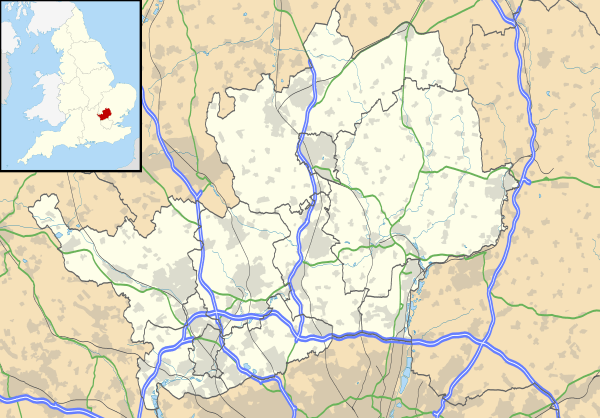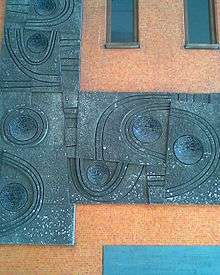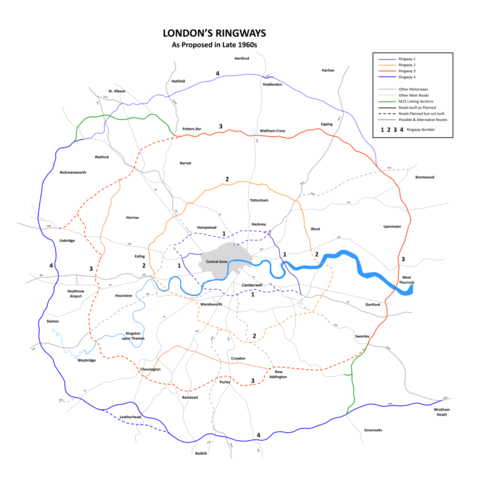Hoddesdon
Hoddesdon (/ˈhɒdzdən/) is a town in the Broxbourne borough of the English county of Hertfordshire, situated in the Lea Valley. It grew up as a coaching stop on the route between Cambridge and London. It is located 3 miles (5 km) West of Harlow 4 miles (6 km) southeast of Hertford, 5 miles (8 km) north of Waltham Cross and 11 miles (18 km) southwest of Bishop's Stortford. At its height during the 18th century, more than 35 coaches a day passed through the town. It saw a boom in the mid 20th century as gravel was extracted from the area, but was exhausted by the 1970s. The lakes and water pits left behind have been used as leisure amenities. Today, Hoddesdon has a little light industry but is mainly a London commuter belt town. The town hosted the eighth Congrès International d'Architecture Moderne in 1951. It is twinned with the Belgian city of Dinant.
| Hoddesdon | |
|---|---|
 Hoddesdon Town Centre | |
 Hoddesdon Location within Hertfordshire | |
| Population | 20,250 [1] 42,253 (2011 Census)[2] |
| OS grid reference | TL365085 |
| District | |
| Shire county | |
| Region | |
| Country | England |
| Sovereign state | United Kingdom |
| Post town | HODDESDON |
| Postcode district | EN11 |
| Dialling code | 01992 |
| Police | Hertfordshire |
| Fire | Hertfordshire |
| Ambulance | East of England |
| UK Parliament | |
The Prime Meridian passes just to the east of Hoddesdon.
The town is served by Rye House railway station and nearby Broxbourne railway station.
History
Early history
The name "Hoddesdon" is believed to be derived from a Saxon or Danish personal name combined with the Old English suffix "don", meaning a down or hill.[3] The earliest historical reference to the name is in the Domesday Book within the hundred of Hertford.[4]
Hoddesdon was situated about 20 miles (32 km) north of London on the main road to Cambridge and to the north. The road forked in the centre of the town, with the present High Street dividing into Amwell Street and Burford Street, both leading north to Ware.[5] From an early date there were a large number of inns lining the streets to serve the needs of travellers. A market charter was granted to Robert Boxe, lord of the manor, in 1253.[3][5][6] By the 14th century the Hospital of St Laud and St Anthony had been established in the south of Hoddesdon. The institution survived the dissolution of the monasteries, but had ceased to exist by the mid 16th century, although it is commemorated in the name of Spital Brook which divides Hoddesdon from Broxbourne.[5]
In 1336 William de la Marche was licensed to build a chapel of ease in the town. The building, known as St Katharine's Chapel, survived until the 17th century, when it was demolished. The tower survived until 1836.[5] The chapel was used by pilgrims to the shrine at Walsingham.[3]
The town was considerably enlarged in the reign of Elizabeth I, and a number of inns in the High Street date from this time.[3] The monarch granted a royal charter in 1559/60, placing the town government under a bailiff, warden and eight assistants. The charter also established a free grammar school based on the site of the former hospital, and this was placed under the care of the corporation. Neither the borough nor the school flourished, however, and both had ceased to exist by the end of the century.[5] In 1567 Sir William Cecil acquired the manor of Hoddesdonsbury and two years later Elizabeth granted him the neighbouring manor of Baas. From that date the Cecils maintained a connection with the town which is recorded by the naming of The Salisbury Arms (anciently the Black Lion Inn) : the title Marquess of Salisbury was granted to James Cecil in 1789.
In 1622 Sir Marmaduke Rawdon built Rawdon House, a red-brick mansion which still survives. Rawdon also provided the town with its first public water supply, flowing from a statue known as the "Samaritan Woman".[3][5][7]
In 1683 there was an alleged Whig conspiracy to assassinate or mount an insurrection against Charles II of England because of his pro-Roman Catholic policies. This plot was known as the Rye House Plot, named from Rye House at Hoddesdon, near which ran a narrow road where Charles was supposed to be killed as he travelled from a horse meeting at Newmarket. By chance, according to the official narrative, the king's unexpectedly early departure in March foiled the plot. Ten weeks later, on 1 June, an informer's allegations prompted a government investigation.[8]
The subsequent history of Rye House has been considerably less dramatic. In 1870 the current owner, William Henry Teale, opened a pleasure garden, displaying the Great Bed of Ware, which he had recently acquired. It was such a popular destination for excursions from London that an extra station was built on the Liverpool Street to Hertford East line to serve it.[9]
By the early 20th century, however, the tourist trade had fallen off, and Rye House was demolished, apart from the Gatehouse; the Great Bed was moved to the Victoria & Albert Museum.[9]
Rye House Gatehouse still stands today, and is now a Grade 1 listed building, with high-quality diaper brickwork and a "barley sugar twist" chimney. It is open to the public at weekends and bank holidays during the summer, featuring displays about the Plot and the early history of brick-building. The rest of the grass-covered site has the floor-plan of the house marked out.[9]
A new chapel of ease, dedicated to St Paul, was built in 1762. This was subsequently rebuilt and enlarged, and in 1844 become the parish church when Hoddesdon was created a separate ecclesiastical parish.[5] Previously the town had been divided between the two parishes of Broxbourne and Great Amwell. The boundary between the two parishes ran through an archway in the town's High Street. When this building was demolished in the 1960s, a specially inscribed stone was set into the pavement marking the historic boundary. In place of St Katharine's Chapel a new clock house was built.[3]
Brewing was first established in the town in about 1700. In 1803, William Christie established a brewery in the town, and it became a major employer and one of the largest breweries in England. The brewery continued in operation until 1928.[10] Most of the brewery buildings was demolished in 1930, although part was converted into a cinema itself since demolished. Some remnants of the establishment remain in Brewery Road.[11]
By the mid-19th century the town still consisted principally of one street, and had a population of 1,743. Malt was being produced and transported to London via the River Lea. There were also a number of flour mills.[12] Trade in Hoddesdon was centred on the hops market each Thursday. As time went on, more and more hops were carried on the river rather than the roads and the Wednesday meat market took predominance. The Wednesday market has survived and a Friday market was added in the late 20th century.
After the Second World War
After the Second World War Hoddesdon increasingly became a dormitory town, forming part of the London commuter belt. Much of the town centre was demolished in the 1960s and 1970s, with the construction of the Tower Centre and Fawkon Walk shopping centres. The opening of a bypass in 1974 changed the nature of the town, with through traffic curtailed.[3]
Hoddesdon is the only small town in Britain with a sizeable Italian community.[13] Many Italian Prisoners of War, who were made to work on farms in the Lea Valley were given land to continue their contribution to the area after the war. Their families emigrated to the Lea Valley in the 1950s and 60s to work in the nearby garden nurseries, and they and many of their descendants still live in the area. Since the 18th century the Lea Valley has had a reputation for fine produce from its market gardens and green houses. The owners and growers of the majority of the Lea Valley's cucumber farms come primarily from two villages in Sicily: Cianciana and Mussomeli.[14] The Lee Valley Growers Association estimates that more than 70% of the 100 or so nurseries in the Lea Valley are now owned by Sicilian descendants, producing 75% of UK-grown cucumbers and 50% of its peppers in their glasshouses.[13]
Part of a wave of immigration to the UK after the Second World War, the Italian community has grown to become part of the fabric of the area, with migrants and their descendants still celebrating their rich Italian heritage.[13] The Festival of San Antonio is celebrated in June with a street procession, although nowadays it is a low-key festival since many of the participants are elderly.[15] An Italian consul is resident at Broxbourne Council. The Italian influx to the Hoddesdon area brought with it many Italian cuisines.
Recent changes
In 2007 Rye House Kart Raceway was taken over by two local family businessmen. It was recently described as the "Silverstone of Karting" by David Coulthard. The Book It Now diary based calendar system was developed here in 2013.
In 2014 JD Wetherspoon's first pub in Hoddesdon opened at the former Salisbury Arms on the High Street. During renovations, a series of 16th century wall paintings claimed to be of national importance were uncovered. They are located on the north wall of the bar, with some additional detail found on one of the beams supporting the ceiling. The paintings depict half-figures and biblical verses.[16]
The pub reverted to its 16th century name, The Star. The images were deemed of great historical and national significance. Roof beams dating to the mid-1400s have also been revealed, suggesting that The Star is older than previously thought.[17]
Governance
Hoddesdon has two tiers of local government: county and district (borough). The area is unparished.
Borough council
Hoddesdon comprises three wards of the Borough of Broxbourne: Hoddesdon North, Hoddesdon Town and Rye Park. Each ward returns three borough councillors to the thirty-eight member council. Councillors are elected by thirds, with one councillor being elected each year except when there are county council elections. As of 2011 all nine of Hoddesdon's councillors are members of the Conservative Party, who hold a large majority on the council.[18]
The borough council is responsible for services such as refuse and planning. Previously owned council housing is the responsibility of the B3Living, a housing association.
County council
Hoddesdon returns two county councillors to the 77 member Hertfordshire County Council. One councillor is elected for each of the two electoral divisions of Hoddesdon North and Hoddesdon South (which also includes Broxbourne).[19] The entire county council is elected every four years. The last elections were held in 2009. Both of Hoddesdon's county councillors are members of the majority Conservative group. At the last local elections Hoddesdon Town and Rye Park returned its first UKIP councillor.
Civic history
Part of Hoddesdon was created an urban district by the Local Government Act 1894, the remainder becoming the parish of Hoddesdon Rural in the Ware Rural District. In 1937 a County Review Order enlarged the urban district by taking in the entire Hoddesdon Rural parish and parts of the parishes of Broxbourne, Great Amwell, Stanstead Abbotts and Wormley. The western boundary of the urban district was fixed by the track of the Roman Ermine Street. Hoddesdon Urban District was abolished in 1974 by the Local Government Act 1972, when it merged with Cheshunt Urban District to become the Borough of Broxbourne.

Education
The John Warner School is a community, foundation comprehensive for 11 to 18-year-olds. Sheredes School served the area from 1969 to 2016. In 2012 Sheredes received the artsmark gold award in recognition of the outstanding work in the arts and was one of only a handful of schools nationally to have been awarded this for a fourth time. After Sheredes closed, the Robert Barclay Academy, a community comprehensive for 11 to 18-year olds took over the site. John Warner has specialist status in Science and sport and Sheredes was well regarded in the arts.
In 2007 the John Warner School received congratulations from Mr Jim Knight, Minister of State for Education for being placed 24th in the '100 most improved schools in the country'. This award is a combination of eight years continuous improvement in examination results.
Sport and leisure
As well as the array of shops in and around Hoddesdon, there are a number of leisure activities in the local area, including a gym in the town centre and the John Warner sports centre, a leisure centre on the outskirts of the town containing a swimming pool and children's activity centre. There is also a Non-League football club Hoddesdon Town F.C., which plays at Lowfield, and a large go-kart track located in nearby Rye park. Around a mile north of the town is Rye House Stadium, home until recently of the Rye House rockets speedway team.
Transport
Bus
| Route Number | Terminals | Via | Operator | Notes | |
| 310 |
Waltham Cross Bus Station | Hertford Bus Station | Cheshunt, Broxbourne, Ware |
Arriva Shires & Essex | Mon-Sun, 5 buses per hour Mon-Fri, 3-4 per hour Sat, 1 per hour Sun. Contactless card payment is accepted on this route. |
| 410 | Waltham Cross Holdbrook Estate, Cheshunt Brookfield Centre | Harlow Bus Station | Cheshunt, Broxbourne | Trustybus | Mon-Sat, 2 buses per hour Mon-Fri to Harlow & to Cheshunt Brookfield Centre (1 per hour continues to the Holdbrook estate via Cheshunt town centre and Waltham Cross bus station). 1 bus per hour Sat to the Holdbrook Estate & Harlow. |
| 641 and 341 | Broxbourne railway station | Hatfield Business Park/UH the forum | Hertford Heath, Hertford Bus Station | Uno | Mon-Sat, 1 bus an hour. Contactless card payment is accepted on this route. |
| C392 | Rye Park | Harlow Waters Lane/ Tylers Cross | Nazeing, Broxbourne |
Epping Forest community transport | Mon-Fri, 1 bus every 60–90 minutes. |
310,341,410 and 641 accept the Intalink explorer ticket. A Wednesday only service is run by Epping Forest Community Transport to Dobbs Weir via Broxbourne.
Railway Services
The nearest railway stations are Broxbourne Station and Rye House Station which offer frequent services to London.
Roads

Hoddesdon contains a small part of Ringway 4, part of the 1960s London Ringways scheme and the only part built north of London further east than Watford.
Linking the town to the A10, the A1170 Dinant Link Road has an overly large junction between the link road and the A10, and was built with space available to continue the road westward over the A10 as originally planned.
Notable people
- Harriet Auber (1773—1862), poet, hymnist
- Arthur James Balfour, 1st Earl of Balfour (1848–1930), Conservative politician and prime minister of the United Kingdom 1902 – 1905. Attended the Grange Preparatory School, Hoddesdon.[20]
- Francis Maitland Balfour (1851–1882), comparative embryologist and morphologist, younger brother of the above, also attended Grange School.[21]
- William Ellis (1794–1872), missionary and author. Lived in the town from 1844, and served as a minister to an Independent congregation. Died at his residence on 9 June 1872.[22]
- William Christie Gosse (1842–1881), explorer and surveyor, was born in Hoddesdon, emigrated to Australia in 1850. In 1859 he entered the Government service of South Australia.[23]
- John Hoole (1727–1803), translator, attended school in Hoddesdon.[24]
- William Josiah Irons (1812–1883), Church of England clergyman and theological writer. Born in Hoddesdon 12 September 1812.[25]
- John Loudon McAdam (1756–1836), engineer and roadbuilder lived in the town from 1827.[26]
- Hugh Paddick (1915–2000), comedy actor, born in Hoddesdon.[27]
- Colin Pratt (born in Hoddesdon 1938), former motorcycle speedway rider.
- Richard Rumbold (c 1622–1685), Cromwellian soldier and conspirator in the Rye House Plot.[28]
- Lena Zavaroni (1963–1999), popular singer and entertainer spent some of her final years in Hoddesdon and is buried in Hoddesdon Cemetery.[29]
- Erik Thorstvedt (1962), Norwegian footballer, played for Tottenham Hotspur between 1989 and 1996. Lived in Hoddesdon during his time at Tottenham.[30]
- David Tree (1915–2009), English stage and screen actor, and nationally prominent commercial grower in Hoddesdon for over sixty years.
See also
- Rye House Power Station
- Hoddesdon Cemetery
- Barclay Park
References
- "Office for National Statistics, 2001 Census, Key Statistics for HCC settlements. Usual resident population (numbers)" (PDF). Archived from the original (PDF) on 26 March 2009.
- "Village population 2011". City Populations. Retrieved 30 October 2016.
- Sue Garside (2008). "Hoddesdon". Rotary Club of Hoddesdon. Retrieved 18 July 2008.
- Open Domesday Online: Hoddesdon
- William Page, ed. (1912). "Parishes: Broxbourne with Hoddesdon". A History of the County of Hertford: volume 3. British History Online. Retrieved 18 July 2008.
- "Markets and fairs". Lowewood Museum. 2008. Archived from the original on 24 July 2008. Retrieved 18 July 2008.
- "Samaritan Woman in Hoddesdon". Lowewood Museum. 2008. Archived from the original on 24 July 2008. Retrieved 18 July 2008.
- "Rye House Plot | English history". Encyclopædia Britannica. Retrieved 22 December 2015.
- (www.communitysites.co.uk), Community Sites. "A historic Hoddesdon house | Rye House | Historic Houses | Places | Herts Memories". www.hertsmemories.org.uk. Retrieved 22 December 2015.
- "Christie Photo Album". Lowewood Museum. 1 June 2007. Archived from the original on 13 July 2011. Retrieved 18 July 2008.
- Allen Eyles and Keith Scone, Cinemas of Hertfordshire, Hatfield, 2003
- Samuel Lewis, ed. (1848). "Hoddesdon". A Topographical Dictionary of England. British History Online. Retrieved 18 July 2008.
- "Lee Valley little Sicily". Hertfordshire. Retrieved 22 December 2015.
- "Olympics 2012: The Sicilian cucumber connection". Telegraph.co.uk. Retrieved 22 December 2015.
- San Antonio Festival Archived 12 August 2010 at the Wayback Machine Retrieved
- "16th century wall paintings uncovered at former Salisbury Arms, Hoddesdon could be of 'national importance'". Hertfordshire Mercury. Archived from the original on 23 December 2015. Retrieved 22 December 2015.
- "Wetherspoon's first Hoddesdon pub, The Star, to open on December 16". Hertfordshire Mercury. Archived from the original on 28 July 2015. Retrieved 22 December 2015.
- "Local councillors". Borough of Broxbourne. 2011. Archived from the original on 22 July 2011. Retrieved 7 May 2011.
- "County Councillors – ordered by district". HertsDirect. Hertfordshire County Council. Archived from the original on 24 July 2008. Retrieved 18 July 2008.
- Ruddock Mackay; H. C. G. Matthew (2004). "Balfour, Arthur James, first earl of Balfour (1848–1930)". Oxford Dictionary of National Biography. Oxford University Press. Retrieved 17 July 2008.
- Brian K Hall (2004). "Balfour, Francis Maitland (1851–1882)". Oxford Dictionary of National Biography. Oxford University Press. Retrieved 17 July 2008.
- Norman Etherington (2004). "Ellis, William (1794–1872)". Oxford Dictionary of National Biography. Oxford University Press. Retrieved 17 July 2008.
- "Gosse, William Christie (1842–1881)". Australian Dictionary of Biography, Online Edition. Australian National University. 2006. Retrieved 29 December 2008.
- Vivienne W Painting (2004). "Hoole, John (1727–1803)". Oxford Dictionary of National Biography. Oxford University Press. Retrieved 17 July 2008.
- G C Boase (2004). "Irons, William Josiah (1812–1883)". Oxford Dictionary of National Biography. Oxford University Press. Retrieved 17 July 2008.
- Brenda J Buchanan (2004). "McAdam, John Loudon (1756–1836)". Oxford Dictionary of National Biography. Oxford University Press. Retrieved 17 July 2008.
- "Obituary: Hugh Paddick". The Independent. 17 November 2000. Archived from the original on 28 September 2008. Retrieved 17 July 2008.
- Robin Clifton (2004). "Rumbold, Richard (c1622–1685)". Oxford Dictionary of National Biography. Oxford University Press. Retrieved 17 July 2008.
- John Van der Kiste (2004). "Zavaroni, Lena Hilda (1963–1999)". Oxford Dictionary of National Biography. Oxford University Press. Retrieved 17 July 2008.
- Bolme, Magnus. "Erik Thorstvedt". Norsk biografisk leksikon (in Norwegian). Kunnskapsforlaget. Retrieved 18 May 2009.
External links
- "Hoddesdon Society Website". Hoddesdon Society. Archived from the original on 10 February 2009. Retrieved 28 March 2009.